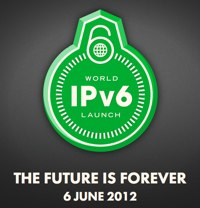 World IPv6 Launch is only 3 months away on June 6, 2012 -
World IPv6 Launch is only 3 months away on June 6, 2012 -
What are you doing today to be ready?
If you don’t already have plans underway, can you think of a simple project to get started? Perhaps look at how to get your home network running IPv6? Or get your website running IPv6?
Here at the Deploy360 Programme, we’ve got some resources that can help – and we’ll be adding more and more to those resources over the next few months:
Beyond our constant stream of new Deploy360 blog posts related to IPv6, you can also now follow World IPv6 Launch activities directly in social media and interact with others who are launching IPv6:
- @WorldIPv6Launch on Twitter
- World IPv6 Launch page on Facebook
- World IPv6 Launch page on Google+
Please follow, like or add the World IPv6 Launch accounts to a circle… and help spread the word that IPv6 launches permanently on June 6, 2012!
And please let us know how we can help you get started with IPv6!


 Our friends over at the
Our friends over at the 
 In preparation for
In preparation for 